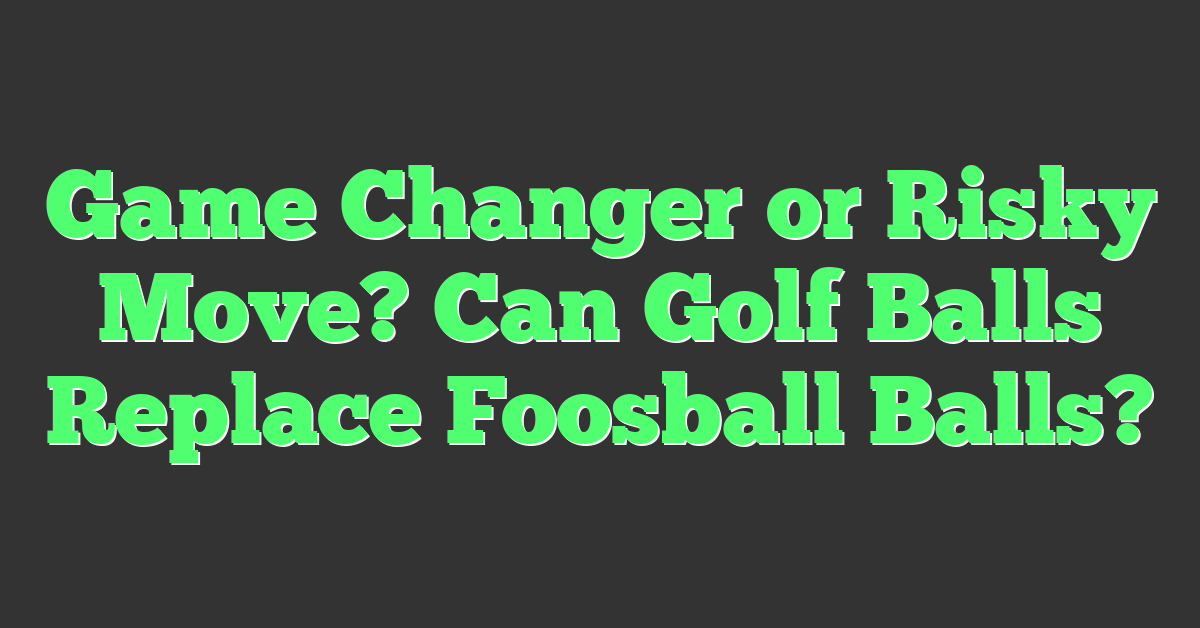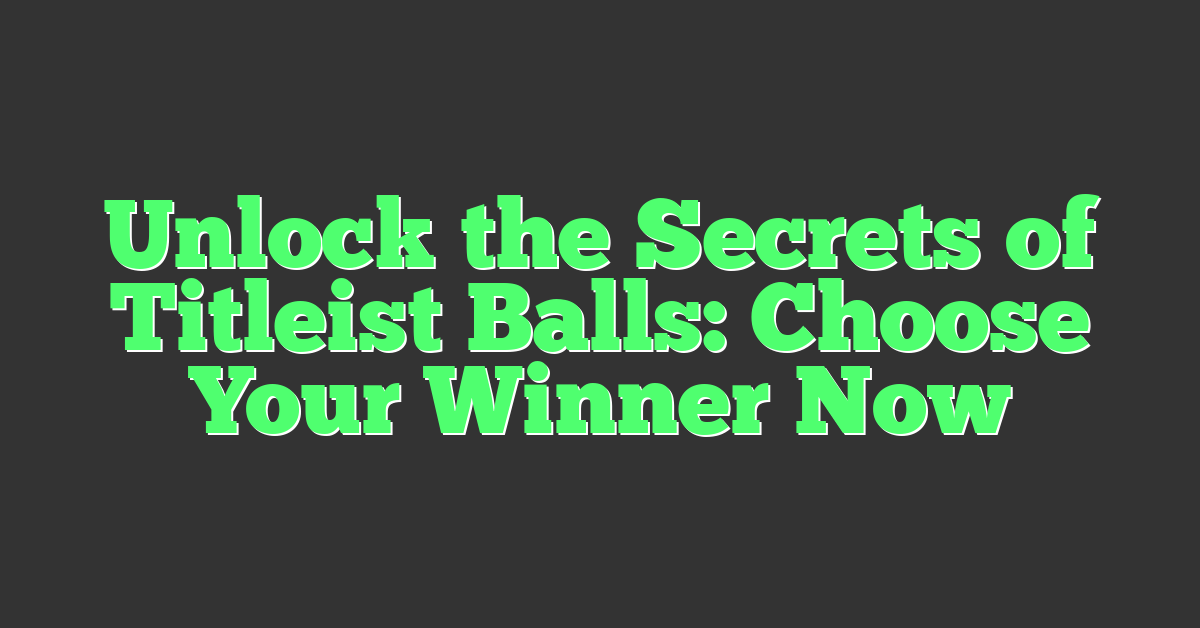Ever found yourself in the middle of a heated foosball game only to realize you’re fresh out of foosball balls? It’s a bummer, right? You might’ve eyed those golf balls sitting in the corner and wondered if they could save the game.

While it might seem like a quick fix, using a golf ball for foosball isn’t your typical hack. It’s like swapping a basketball for a soccer ball—sure, they’re both round, but that’s about where the similarities end. Let’s tee up this quirky idea and see if it’s a hole-in-one or a swing-and-a-miss for your foosball fun.
The differences between golf balls and foosball balls
As you dive into the intricate world of golf, you’re always looking for ways to refine your game. Understanding the equipment is a key part of that. Now, imagine trying to tee off with a foosball ball instead of your trusty golf ball. Absurd, right? That’s because golf balls and foosball balls are engineered for their specific sports, and each has unique features that make them unsuitable substitutes for one another.
Golf balls are designed for distance and precision. They have dimples – typically between 300 to 500 – which reduce drag and allow the ball to travel further. These dimples affect the aerodynamics, a critical element in your quest for that perfect drive. Golf balls are generally 1.68 inches in diameter and weigh about 1.62 ounces, tailored to meet strict regulations set by the USGA and R&A.
Foosball balls, on the other hand, are made for control on a foosball table. They lack the dimples of a golf ball and are smoother, aiming to provide a consistent roll and better grip against the foosball men’s feet. Foosball balls vary in size, but are typically around 1.365 inches in diameter, which is smaller than a golf ball. Their weight, usually around 0.9 ounces, is also lighter, which affects the pace and flow of the game on the table’s surface.
- Golf balls:
- Foosball balls:
Why does this matter to you as a golfer? Well, knowing the science behind ball design can help you appreciate the precision required in golf. Each piece of equipment is a result of meticulous planning and testing, much like your approach to the sport. By understanding the differences, you can better appreciate the nuances of your equipment, making informed decisions that could shave strokes off your game.
Can you use golf balls as a substitute for foosball balls?
You’ve got a knack for golf, and your low handicap is proof of your dedication. You understand the intricacies of golf balls and how their design greatly affects your performance on the course. Now, let’s indulge a bit of curiosity. In a pinch, could you swap out foosball balls with golf balls?
First off, you already know golf balls are precision-engineered for distance and aerodynamics. Their size, weight, and especially those dimples, all play into how they perform when struck with your driver or iron. They’re meant to fly long distances and react to spins and strikes uniquely suited to the verdant fairways and manicured greens.
In contrast, foosball requires a ball that’s designed for a completely different kind of finesse and control. Foosball balls are usually made of materials like cork or textured rubber, which enhance grip and maneuverability on the foosball table’s surface. They’re smaller and built for quick, lateral movements and sharp manipulations – a far cry from the long arcs and precision control you’re used to in golf.
Here’s the rub: using a golf ball in a foosball game would be like bringing a putter to a soccer match. Not only would the golf ball potentially damage the foosball table with its hard exterior, but you’d also find it lacks the necessary traction for the quick stops and starts essential in a fast-paced foosball game.
Furthermore, consider the weight. Golf balls tend to be heavier, and if used in a foosball game, they could affect the feel and dynamic of the rods and players, making them more cumbersome to handle. Plus, a golf ball’s weight may even cause premature wear or damage to your foosball table.
While you might be creatively thinking outside the tee box, golf balls just aren’t designed for the role of foosball balls. In both golf and foosball, using the right equipment is key to not only playing correctly but improving your game and scoring those lower numbers you’re always after. Keep each ball in its own game, and you’ll be sure to maximize your performance in both arenas.
The potential risks and limitations of using golf balls for foosball
While you’ve mastered the fairways and greens, translating those skills to a foosball table with golf balls isn’t a hole-in-one. There are inherent risks and limitations to consider when substituting foosball balls with golf balls.
Firstly, weight and hardness are critical points. Golf balls are heavier and harder than their foosball counterparts. This difference can lead to:
- Increased Wear and Tear: The solid design of a golf ball can damage foosball table surfaces, men figures, and the rods.
- Difficult Control: Maneuvering a golf ball on a foosball table requires significantly more effort, often resulting in a loss of finesse and game flow.
Table Balance is another consideration. Golf balls are not designed for a flat surface game; they could roll unpredictably, affecting gameplay. Control of the ball is paramount in foosball, and with a golf ball, precise shots are next to impossible. This frustration can detract from your ability to execute skillful plays.
The potential for injury should also be weighed. When a hard, heavy golf ball is struck forcefully, it becomes a projectile. In the close quarters of indoor gameplay, this could pose a hazard.
Lastly, there’s the factor of Experience Detriment:
- Authentic Feel: Using a golf ball disrupts the authentic feel of a foosball game.
- Skill Transfer: The skills you’ve honed on the golf course don’t translate well to a game designed for a completely different kind of ball.
As you refine your skills on the links, remember that equipment is tailored for the sport. Every seasoned golfer knows the right club makes all the difference, just like the right ball does in foosball.
Tips for using golf balls for foosball, if you really must
Sometimes, you’re in a pinch and a golf ball is all you’ve got for a game of foosball. While it’s not ideal, there are a few things you can do to make this unorthodox substitution work somewhat better.
First, choose a softer golf ball. Surlyn® covered balls tend to be harder and could cause more damage to your foosball table. Look for those with a urethane cover; they’re typically softer and will be less harsh on the table’s surface.

Reduce your game’s intensity. Normally, foosball is played at a high speed, but with a golf ball, you need to keep the pace down to prevent damage. The force of a golf ball can dent the figures and warp the playing field if you’re not careful.
Here’s an unusual tip – slightly dampen the golf ball’s surface. This can increase the grip and manageability on the hard table surface. However, keep in mind that moisture can also damage the foosball table in the long run, so use this tactic sparingly.
Practice delicate ball control. The more finesse you use, the less likely you’ll damage your equipment. This will also challenge and possibly improve your hand-eye coordination and control, attributes that can translate well to your golf game.
Lastly, consider customizing your table. If using a golf ball becomes a regular affair, then why not adjust the playing field? Placing a thin layer of protective material over the surface can shield it from the impacts while maintaining game quality.
Remember, these tips are for those rare instances when a golf ball is your only option. It’s always best to stick to the right equipment for the task at hand to preserve the integrity of both your foosball table and your golf balls.

Conclusion
So next time you’re in a bind and can’t find your foosball ball, remember you’ve got options. A golf ball can come to the rescue, especially if you choose a softer one and play gently. Just dampen it a touch for better control but be careful not to overdo it. If golf balls become your go-to, think about adding that protective layer to your table. But let’s not forget, while it’s a fun workaround, nothing beats using the real deal for each game. Keep those golf balls on the green and foosball balls on the table, and you’ll keep both your games and gear in top shape.










